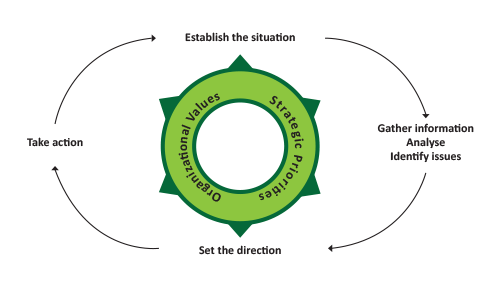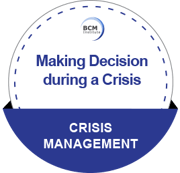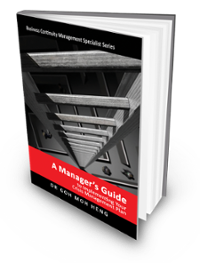Decision-Making Process
We can think of the decision-making process as consisting of these eight basic steps:
1. Setting the Stage
An organization select its participants and determine the approach the organization will take to reach a decision:
- Should the organization adopt and aim for consensus or vote by the majority?
- During the meetings, especially the earliest ones, the organization set the tone for the group by encouraging open dialogue and promoting healthy debate.
2. Recognizing Obstacles
Certain individual biases and group dynamics can be obstacles in the decision-making process. By predicting and recognizing these tendencies, the organization can avoid them.
3. Framing the Issue at Hand
A successful decision depends on a clear understanding of the issue and its cause(s).
4. Generating Alternatives
After the organization has clarified the issue, brainstorm and generate creative conflict to develop alternative courses of action and ways of proceeding.
5. Evaluating Alternatives
The organization access the feasibility, risk, and ethical implications of each possible course of action.
6. Making a Decision
The organization choose an alternative.
7. Communicating the Decision
The organization decide who should be notified of the organization's decision and communicate it effectively.
8. Implementing the Decision
The organization determine what tasks will be required to put the decision into action, assign resources, and establish deadlines.
Throughout this eight-step process, the organization continually assesses its decision-making effectiveness and makes changes as needed to improve it.
Strategic Crisis Decision-Making
Decision-making
Decision-making, as defined in BS 11200:2014, is the process that leads to selecting a course of action from more than one alternative option. This standard has since been superseded by ISO 22361:2022.
The challenge of crisis decision-making is frequently underestimated, ignored or unknown, except with the benefit of hindsight. Even the most clear-headed and decisive senior executive in day-to-day settings can be overwhelmed in a crisis, leading to uncharacteristic errors, decision avoidance or delays.
Good decision-making at the strategic level can steer an organization out of crisis and on to future success. In contrast, bad decision-making almost certainly exacerbates an already difficult situation and potentially negatively impacts the reputation and value of the organization.
At its core, crisis response involves making decisions based on the best information available and turning those decisions into direction and action that control events and minimize the impacts of the crisis.
How Are Decisions Made?
A wide range of decision-making models exists, and the practically useful ones are organized around three primary considerations.
1. Situation
What is happening, what are the impacts, what are the issues, what are the risks, what might happen and what is being done about it? Situational awareness involves an appropriate knowledge of these factors.
2. Direction
What end-state is desired, what is the crisis response's aim and objectives, and what overarching values and priorities will inform and guide this?
3. Action
What needs to be decided, and what needs to be done to resolve the situation and achieve the desired end-state? The effectiveness of actions should be monitored and reported on.
The essential decision model is: to analyze the situation, identify the issues, generate options, evaluate the options concerning the desired end-state, and make a decision or choice, all of which should be consistent with the values and the strategic priorities of the organization. Ideally, strategic decision-making in a crisis also follows a step-by-step process made up of the stages, as shown in the diagram below.

Strategic Decision-making in a crisis
This process seems logical and straightforward, except that these types of rational models assume the decision maker is fully informed, can compute the outcomes of a choice with perfect accuracy and is thinking entirely rationally. The reality is often different.
Why is Decision-making in a Crisis Challenging?
Studies of decision-making by people in real-life crises have shown that they do not always follow a clear-cut decision process. The nature of crises creates an environment that potentially derails the rational decision-making process at both strategic and tactical levels during crisis response.
The crisis is a unique and challenging decision-making environment compared to day-to-day business, with unique characteristics.
All these factors place extreme psychological pressures on the CMT and other affected staff across the organization. However, the high levels of uncertainty that characterize the majority of crises, caused by a lack of knowledge and a plethora of rumours, assumptions, and misinformation, are particularly threatening to effective decision-making. Uncertainty significantly increases a decision maker’s stress levels, which can negatively affect their cognitive processes, and increases the likelihood of flawed decisions and poor decisions.
The challenges to good decision-making are clear, but even overcoming these challenges does not guarantee a successful or “good” outcome. However, good decision-making significantly increases the likelihood of success.
Dilemmas, Decision Delay, and Decision Avoidance
Crisis decision-making is typically characterized by ill-formulated dilemmas, for which apparent solutions are not right or wrong but better or worse and where solutions to one problem potentially generate further problems or issues. Such dilemmas are perceived as having no good outcome and potentially leading only to more or less bad outcomes. These dilemmas induce exceptionally high levels of stress and anxiety in the decision-maker.
While uncertainty might not increase the chances of the CMT actively making large-scale errors or wrong choices, uncertainty over the potential outcome of a decision can block or delay the CMT from implementing those crucial decisions that should be made to take control of the crisis.
One of the main reasons for this is the CMT’s perceived accountability over a decision that might, with hindsight, be judged by interested parties as having been the wrong choice. Therefore, doing nothing might be perceived as less blameworthy than an actively-made mistake. However, the failure to make crucial decisions and take action when required is one of the most pervasive problems that decrease the effectiveness and efficiency of the crisis response and which has produced tragic outcomes in crises.
Decision-making Problems
Decision-making is beset with complexity, not only in the issues being faced but with the dynamics of how decisions are made and the biases flowing around when a group is brought together to consider a problem. Good leaders and decision-makers are aware of the risks and pitfalls they face to balance approaches and ensure as much bias can be taken out of the final stages as possible.
This text cannot comprehensively review potential biases and pitfalls, but self-awareness is critical. Crisis leaders and decision-makers should be mindful of potential problems, such as:
- Groupthink;
- The tendency to seek or prioritize information that confirms a preferred interpretation or option at the expense of contradictory information (which might be correct and relevant);
- Wishful thinking;
- Stereotyping;
- Disproportionate emphasis given to preferred sources;
- A failure to challenge assumptions of various types; and
- Premature closure on a particular interpretation, position or path of action.
Effective Crisis Decision-making
Some factors improve the effectiveness of strategic decision-making in a crisis. This include:
- Implementing, at an organizational level, policies, structures (teams and roles), plans, processes and tools to support the organization’s crisis management capability as a whole and the CMT in particular;
- Gaining experience in crisis decision-making environments as individuals and teams;
- Training CMT members in the use of decision techniques to reduce the effect of uncertainty on their cognitive abilities; and
- Recognizing the signs of weak decision-making, including a failure to challenge evidence, assumptions, methods, logic and conclusions, and adopting measures to provide alternative perspectives.
Decision-makers need to be aware of their challenges and understand that there are tools and techniques available to support them in managing uncertainty, to reduce the likelihood of them making either individual or collective decision errors.
Find out more about Blended Learning CM-300 [BL-CM-3] & CM-5000 [BL-CM-5]
 |
 |
 |
 |
 |
![[BL-CM] [5] Register](https://no-cache.hubspot.com/cta/default/3893111/82024308-16f4-4491-98be-818a882c6286.png) |
 |
![Email to Sales Team [BCM Institute]](https://no-cache.hubspot.com/cta/default/3893111/3c53daeb-2836-4843-b0e0-645baee2ab9e.png) Please feel free to send us a note if you have any of these questions Please feel free to send us a note if you have any of these questions |
 |






